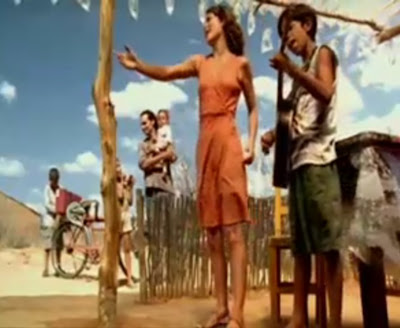
The AIDS epidemic has become one of the greatest problems in modern day society. In this film, the audience is shown a family struggle with the HIV virus. It’s a common scenario where the husband is in the nearest mine working while the mother and daughter live in a Zulu village in the rural countryside. The nearest healthcare clinic is half a day’s walk. Yesterday is sick and it takes several attempts, each resulting in a rejection, before a friend arranges for a van to take her. She quickly learns that HIV is the problem.
Yesterday travels to the mine where her husband works to give him the news. After she tells him, he beats her for several minutes while a security guard looks the other way completely un-concerned. The two return home together and are avoided by the local villagers whom are like family. The people talk about not letting their kids play near them and much discomfort is felt by everyone.
Surprisingly, no one in the village seems to know that AIDS is transmitted mainly during sex. The women are awestruck during an educational seminar dealing with related issues to the disease. Even after the seminar there is a lot of tension felt by Yesterday from other villagers.
AIDS has been recognized by the U.S. Centers for Disease Control and Prevention in 1981. Since then it has been a large concern across the globe. It’s hard to believe that there are people who don’t know about it in the most influenced region in the world. In Johannesburg, businesses have free condoms in the place where you might expect to find candy if you’re a westerner. The fact is that the population growth is rapidly approaching 0% and life expectancy is only 49 and it is dropping. There will probably be negative growth numbers for South Africa as well as many northern neighboring countries. Political folly is part of the problem while crime and poverty are also major factors.
Organizations such as the National AIDS Co-ordination Program (NACP), have been set up but delayed for years due to political reasons. The NCAP in Zimbabwe was developed in 1987; there was no national policy written until 1997! Current education efforts include teaching from grade school and up. Public seminars and advertisements as well as condom distribution is common. President Bush also signed for a $15 billion dollar plan that will aim to prevent 7 million new infections as well as treat two million. The plan will also provide for orphans and people who need financial assistance that are affected by HIV/AIDS.
1000 deaths occur everyday because of this disease and the entire Southern part of Africa is suffering heavily from it. Education is the main weapon to control this pandemic. This was one of the main points of the movie after Yesterday returned to the village. Her name is also perhaps symbolic of a way of life that is disappearing in this region. Her father explained to her and her daughter that he used to run through the countryside like a leopard. At that time he could only take a few steps under his own power displaying the irony upon him.
In reality, mineworkers are one of the most at risk groups categorized alongside prostitutes. Drastic measures are needed today so that this region as well as the world, has a chance to win the fight against AIDS. Ideally it could be contained over time and careful measures could prevent anyone carrying it into future generations. For now it will continue to devastate the lives of the 5 million or more in South Africa alone that are infected.



















